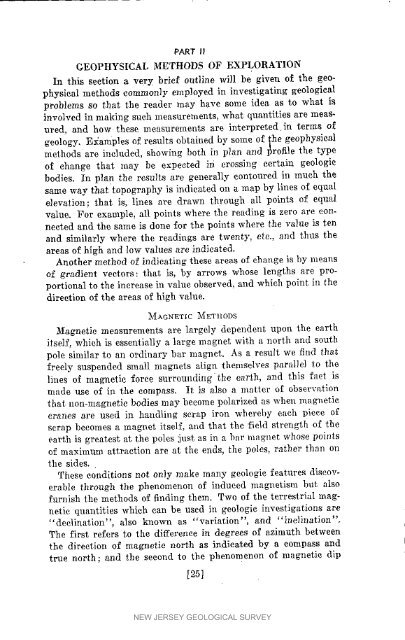Bulletin 54. Geophysical Methods of Exploration and their ...
Bulletin 54. Geophysical Methods of Exploration and their ...
Bulletin 54. Geophysical Methods of Exploration and their ...
You also want an ePaper? Increase the reach of your titles
YUMPU automatically turns print PDFs into web optimized ePapers that Google loves.
PART D<br />
GEOPHYSICAL METHODS OF EXPLORATION<br />
In thissectiona very briefoutli_en,illbe given o_ the geophysicalmethods<br />
commonly employed in investigatingeological<br />
problems so that the reader may have some idea as to what is<br />
involved in making such measurements, what quantities are measured,<br />
<strong>and</strong> how these measurements are interpreted_in terms <strong>of</strong><br />
geology. E_/amples <strong>of</strong> results obtained by some <strong>of</strong>}he geophysical<br />
methods are included, showing both in p]an <strong>and</strong> l_r<strong>of</strong>ile the type<br />
<strong>of</strong> change that may be expected in crossing certaizt geologic<br />
bodies. In pla n the results are generally contoured in much the<br />
same way that topography is indicated on a map by lines <strong>of</strong> equal<br />
elevation; that is, lines are drawn through all points <strong>of</strong> equal<br />
value. For example, all points where the reading is zero are connected<br />
<strong>and</strong> the same is done for the points where the value is ten<br />
<strong>and</strong> similarly where the readings are twenty, etc., <strong>and</strong> thus the<br />
areas <strong>of</strong> high <strong>and</strong> low values are indicated.<br />
Another method <strong>of</strong> indicating these areas <strong>of</strong> change is by means<br />
<strong>of</strong> gradient vectors: that is, by arrows whose lengths are proportional<br />
to the increase in value observed, <strong>and</strong> which point in the<br />
direction <strong>of</strong> the areas <strong>of</strong> high value.<br />
_{AGNETIC<br />
METHODS<br />
Magnetic mess,lrements are largely dependent upon the earth<br />
itself, which is essentially a large magnet with a north <strong>and</strong> south<br />
/3o]e similar to an ordinary bar magnet. As a resu/t we find that<br />
freely suspended small magnets align themselves parallel to the<br />
lines <strong>of</strong> magnetic force surrounding the earth, trod this fact is<br />
made use <strong>of</strong> in the compass. It is also a matter <strong>of</strong> observation<br />
that non-magnetic bodies may become polarized as when magnetic<br />
cranes are used in h<strong>and</strong>ling scrap iron whereby each piece <strong>of</strong><br />
scrap becomes a magnet itself, <strong>and</strong> that the field strength <strong>of</strong> the<br />
earth is greatest at the poles just as in a b_r magl_et whose poiz_ts<br />
<strong>of</strong> maximum attraction are at the ends, the poles, rather than on<br />
the sides.<br />
These conditions not only make many geologic features discoverable<br />
through the phenomenon <strong>of</strong> induced magnetism but also<br />
furnish the methods <strong>of</strong> finding them. Two <strong>of</strong> the terrestriaI magnetic<br />
quantities which can be used in geologic investigations are<br />
"declination", also known as "variation", <strong>and</strong> "iz_c}ination".<br />
The first refers to the difference in degrees <strong>of</strong> azimuth between<br />
the direction <strong>of</strong> magnetic north as indicated by a compass <strong>and</strong><br />
true north; <strong>and</strong> the second to the phenomenon <strong>of</strong> magnetic dip<br />
[25_<br />
NEW JERSEY GEOLOGICAL SURVEY

















